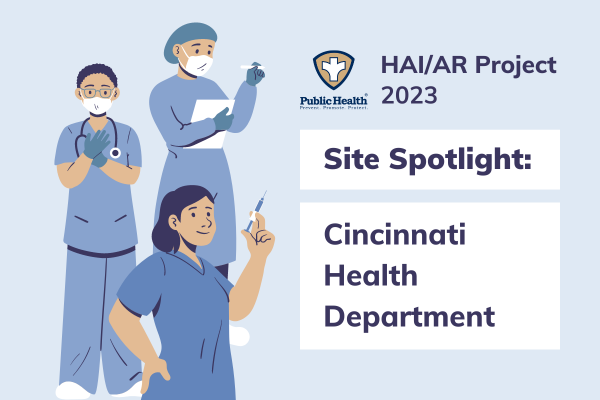The National Association of County and City Health Officials (NACCHO), the voice of the country’s nearly 3,000 local health departments, with support from the Centers for Disease Control and Prevention (CDC), Division of Healthcare Quality and Promotion, awarded eleven local health departments with funding to support the Local Health Department Healthcare-Associated Infections and Antimicrobial Resistance (HAI/AR) project. These funds supported their ability to pilot and implement the CDC (Interim) Local Health Department Strategy for HAI/AR.
HAIs are among the leading causes of preventable deaths in the United States. The CDC estimates that one in 31 hospital patients are infected with at least one HAI, and AR is a major public health threat that compounds the challenge of HAIs. Antimicrobial-resistant infections cause more than 35,000 deaths each year, and nine of the top 18 infections considered to be the highest AR threats are often associated with healthcare settings.
The selected local health departments used the CDC (Interim) Local Health Department Strategy for HAI/AR to enhance the capacity of HAI/AR prevention and response, including through conducting infection control assessments, strengthening antimicrobial stewardship efforts, improving laboratory coordination, and enhancing HAI/AR data reporting and access. They also coordinated with stakeholders at the local and state levels to advance these efforts.
We asked our HAI/AR pilot project sites to reflect on their experiences and lessons learned since joining our project. Here is what one of our sites, the Cincinnati Health Department, shared with us. A standalone version of their blog post can be found here.
HAI/AR Background: Cincinnati Health Department
“The Cincinnati Health Department Communicable Disease Prevention and Control Unit (CHD CDU) was made up of one supervising epidemiologist, three communicable disease nurses, and one administrative technician in January of 2020. Prior to this, the unit responded to healthcare-associated infections and outbreaks at the direction of Ohio Department of health (ODH). There were two cases of MDROs reported in 2017, four cases in 2018, and nine cases in 2019.
As the COVID-19 pandemic emerged in 2020 and took over all public health response, healthcare-associated infections (HAI) and antimicrobial resistance (AR) silently spread in the region. CHD and ODH investigated the first case of Candida auris (C. auris) diagnosed in Ohio in May 2020 as well as jointly investigated the first outbreak of C. auris at a hospital in Ohio in August of 2021. Since the beginning of 2020, the number of cases and clusters of healthcare-associated infections (HAIs) at facilities grew to 197 by December of 2022.
While many supplemental staff had been added for the purpose of investigating and responding to COVID-19, HAI/AR investigations overwhelmed existing full-time staff and capabilities. CHD applied for and was awarded the NACHCO LHD HAI/AR Pilot Project Grant opportunity at the end of December 2022, in hopes of organizing a plan to build capacity to respond to emerging multidrug-resistant organism (MDRO) disease reports and facility outbreaks in cooperation with the OODH HAI Team, engage key local health department (LHD), hospital, and long-term care facility (LTCF) partners, and ultimately reduce the spread of HAI and AR occurrences in the region. Below are the steps that were taken:
- CHD CDU met with CHD leadership to discuss concerns regarding the spread of C. auris in the region and general resistance from facilities to follow state recommendations.
- CHD presented a C. auris briefing to the CHD Board of Health public meeting to alert them and the public we serve to the growing number of cases being diagnosed by facilities in our jurisdiction.
- CHD shared Southwest Ohio region C. auris data analysis with partners and stakeholders and responded to media requests following the CDC alert regarding the alarming increase in C. auris cases over the last 3 years in the U.S.
- CHD reached out to the University of Cincinnati’s Master of Public Health program to seek students interested in volunteer or paid HAI/AR public health opportunities. Interviews were conducted and two students were selected for potential paid internships and six others were offered volunteer internships.
- CHD created a survey to assess the HAI/AR knowledge of local and regional healthcare providers and shared the survey during regional meetings.
- CHD sought opportunities to present HAI/AR awareness and education presentations in regional meetings. Presentations were made and pre- and post-surveys were conducted in the weekly Southwest Ohio Regional Infectious Disease meeting, the Monthly SW Region Large Hospital/Skilled Nursing Facility meeting, and the monthly Cincinnati/Dayton Ohio APIC Chapter meeting.
- CHD presented a remote local LTCF education and awareness training program that was recorded and sent to all licensed LTCFs in the jurisdiction.
- CHD invited regional providers to join a public health/healthcare provider workgroup to collaborate on solutions to slow the spread of C. auris in the Southwest Region.
- CHD presented to EPIC leadership at the invitation of the Health Collaborative to seek solutions to communication gaps between system medical records. The presentation explored “flagging” patient records as needed to alert receiving facilities about a patient’s C. auris or other MDRO colonization/infection.
- CHD staff have been able to apply for APIC CIC certification and study resources.
- CHD continues to participate in regional ODH-led C. auris meetings, provider-public health meetings, and regional stakeholder meetings, and continues to keep CHD leadership informed.
- CHD CDU’s epidemiologist also joined the CSTE HAI/AR workgroup and attended the 2023 CSTE Conference.
- CHD’s Assistant Commissioner attended the 2023 NACCHO Conference.
Through the knowledge and the skills made available, CHD was able to prioritize and analyze the C. auris investigations and outbreaks and develop a strategy to address facility-specific issues, resulting in a very successful partnership with the first hospital on the list of priorities. Multiple presentations were provided to staff groups (nurses, environmental services, transport, therapy, etc.) that were very well received. The facility conducted the recommended point prevalence screenings in affected units and developed an admission screening strategy. This will hopefully be the first of many future success stories in the CHD HAI/AR strategy!”



